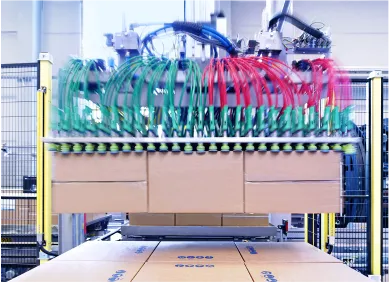PACKAGING MATERIAL
Sterilizing pharmaceutical primary packaging, biotechnology, cosmetics, and food packaging.
Irradiation of Packaging Materials
Sterile and Bioburden-reduced Packaging
Sterilization of products and packaging is essential in many production processes to ensure reproducible results, product quality and safety. The trend towards avoiding preservatives in the manufacture of cosmetic products or foodstuffs makes effective packaging sterilization necessary and contributes significantly to consumer protection. Various processes can be used to sterilize packaging materials. At BGS, we rely on ionizing radiation and can advise you on all aspects of E-Beam irradiation.
Typical applications
Sterilization of pharmaceutical primary packaging materials
Adherence to and compliance with standards for the sterilization of medical devices (ISO 13485 and ISO 11137) are common practices for the sterilization of primary pharmaceutical packaging. One reason for this is that the packaging’s function is not limited to enclosing a product and facilitating transportation. Pharmaceutical primary packaging comes into direct contact with the drug (e.g., injectable solutions, vaccines). Packaging therefore plays an important role in how the product is stored and used. Sterilized packaging is required by law and essential for the protection of patients. Among other things, we regularly sterilize these products for our customers:- Ampoules
- Pouches
- Bottles
- Cans and tubes
Sterility or bioburden reduction
Normative specifications are decisive
Sterility is defined as: In one million products whose sterilization has been validated using a suitable method, no more than one viable microorganism may be detectable. Packaging is only sterile if the theoretical probability of finding one viable microorganism per device is no more than 1 in 1,000,000.
Sterility is a legal requirement for primary pharmaceutical packaging that is in direct contact with the dosage form or may come into contact with it. Packaging materials for liquid and moist pharmaceuticals must be sterile as they offer ideal growth conditions for microorganisms due to the moisture content in a closed system. It is necessary for these packaging materials to undergo a validation process.
Bioburden Reduction
If packaging is bioburden-reduced, the quantity of microorganisms is below a limit value that is considered safe for a particular application. With these products, the theoretical probability of finding one surviving microorganism per article after the treatment process is less than 1:1,000.
This consideration is particularly relevant for packaging in the food industry. Radiation-treated packaging reduces the likelihood of contamination with pathogenic germs and contributes to a longer shelf life of the food. Radiation sterilization quickly and efficiently sterilizes packaging including bag-in-box systems, inliners, and closures by complying with regulatory standards.
Radiation sterilization
Bioburden-reduced and sterile products — fast, safe, and reliable
Various processes and technologies can be used to convert packaging into a bioburden-reduced state or to sterilize it. Treatment with beta rays is one of the most common methods. Microorganisms reliably lose their ability to reproduce, and die from irradiation.
Irradiation technology offers several advantages: The process is free from chemicals and does not cause any significant increase in temperature during the process. As the radiation dose can be precisely controlled, radiation sterilization also offers a high level of reliability and reproducibility. E-Beam can be used to irradiate individual packages within a few seconds.
We treat the products in their transport packaging without contact. This ensures bioburden reduction and sterility during shelf life. After irradiation, the products are immediately checked by our quality assurance department and released to the customer. Radiation sterilization, especially E-Beam, is especially well-suited to time-sensitive supply chains.


